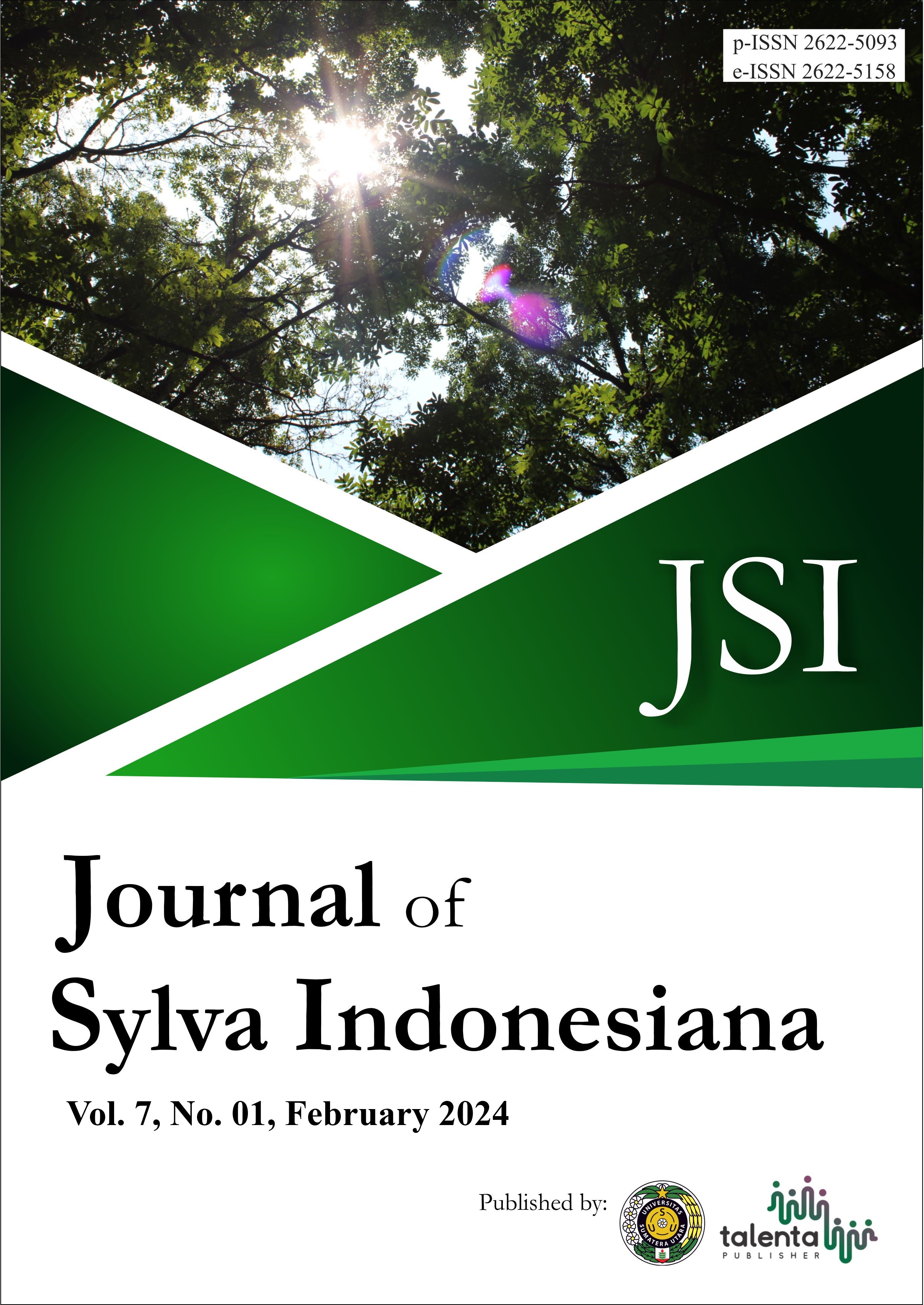The Fungal Development During The Leaf Litter Process Decomposition of Avicennia marina
DOI:
https://doi.org/10.32734/jsi.v7i01.11229Keywords:
Avicennia marina, Decomposition, Fungi, Leaf Litter, MicroorganismsAbstract
The existence of mangrove ecosystems decreases from land conversion into residential areas, industries, plantations, road facilities and the construction of ponds. This research was conducted in the mangrove forest area of Secanang Belawan Village, Medan, at the Biotechnology Laboratory of the Department of Forestry, Faculty of Agriculture, USU and at the Microbiology Laboratory, Department of Biology, Faculty of Mathematics and Natural Sciences, USU Medan. The study's objective was to identify the different fungal species that were present at 10 ppt salinity levels, 10–20 ppt, and 20–30 ppt as well as the pace at which Avicennia marina leaf litter. The research method used litter bags filled with leaf litter of Avicennia marina (50 g) with 7 treatments, 3 replications and 3 levels of salinity. The A. marina leaf litter that had a salt level of 10 ppt had the highest level of decomposition. The dry weight of leaf litter left in the litter bag, which is 4.92 g on average. The largest dry weight of the remaining litter was found in an environment with a salinity of 20 – 30 ppt, which is an average of 10.42 g. The rate of decomposition of A. marina leaf litter in an environment with a salt level greater than 30 ppt is 6.53/yr (or almost equal to residence period of = 0.15 yr). The number of fungal species discovered in the leaf litter of A. marina, which goes through a breakdown process at salinity levels between 0 and 10 ppt and contains 9 species, is another way to observe the impact of salt level. In comparison to the large at salinity levels of 10 to 20 ppt and 20 to 30 ppt, respectively, there were populations of fungus that underwent the process of decomposition in A. marina leaf litter, with an average of 5.99 x 102 cfu/ml and 5.5 x 102 cfu/ml, the fungal population that was the highest concentration was 10.72 x 102 cfu/ml
Downloads
References
Zafar Farooqui , Pirzada Jamal Siddiqui, Munawwer Rasheed. 2014. Changes in Organic, Inorganic contents, Carbon Nitrogen ratio in decomposing Avicennia marinaand Rhizophora mucronataleaves on tidal mudflats in Hajambro creek, Indus delta, Pakistan. The Journal of Tropical Life Science open access vol. 4, no. 1, pp. 37-45.
Linge MPL, Atta N, Tsuchiya M. 2002. Nutrient dynamics and leaf litter decomposition in a subtropical mangrove forest at Oura Bay, Okinawa, Japan. Trees. 16: 172–180
Robertson AI. 1988. Decomposition of mangrove litter in tropical Australia. J Exp. Mar. Biol. Ecol. 166: 235-247
Marta Filipa Simo es, Andre Antunes, Cristiane A. Ottoni, Mohammad Shoaib Amini , Intikhab Alam, Hanin Alzubaidy, Noor-Azlin Mokhtar , John A.C. Archer, Vladimir B. Bajic. 2015. Soil and Rhizosphere Associated Fungi in Gray Mangroves (Avicennia marina) from the Red Sea A Metagenomic Approach. Genomics Proteomics Bioinformatics 13. 310–320
Waring, R. H., dan W. H. Schlessinger. 1985. Forest Ecosystems-Concepts and Management. Academic Press, Orlando, Florida.
Yunasfi, S. Hadi, C. Kusmana, L. I. Sudirman and B. Tjahjono. 2006. Decomposition of Avicennia marinaLeaf Litter by Bacteria and Fungi (Dissertation). Bogor Agricultural Institute.
Alongi DM. Bacterial productivity and microbial biomass in tropical mangrove sediments. 1988. Microb Ecol ;15:59–79
Liu P, Wang XH, Li JG, Qin W, Xiao CZ, Zhao X. 2015. Pyrosequencing reveals fungal communities in the rhizosphere of Xinjiang jujube. Biomed Res Int 2015;2015:972481[9] Arfi Y, Marchand C, Wartel M, Record E. 2012. Fungal diversity in anoxic-sulfidic sediments in a mangrove soil. Fungal Ecol 5:282.[10]Ghizelini AM, Mendonca-Hagler LCS, Macrae A. 2012. Microbial diversity in Brazilian mangrove sediments: a mini review. Braz J Microbiol;43:1242–54.[11] Narayanasamy Rajendran & Kandasamy Kathiresan.2006. Microbial flora associated with submerged mangrove leaf litter in India. Rev. Biol. Trop. 55 (2): 393-400.
Journal of Sylva Indonesiana Vol.07, No.01(2024) 1–88[12]Kathiresan, K., dan B. L. Bingham. 2001. Biology of Mangrove and Mangrove Ecosystems. Centre of Advanced Study in Marine Biology, Annamalai University. Huxley College of Environmental Studies, Western Washington University. Annamalai, India.[13]Farooqui Z, Siddiqui PJ, Shafique S, Ali A, Iqbal P. 2012. Assessment of litter production in semi arid mangroves forests near active Indus river mouth (Hajambro creek) and Karachi backwaters, Pakistan. Pak .J. Bot. 44(5): 1763-1768.[14]Freudenthal T, Wagner T, Wenzhofer F, Zabel M, and Wefer G. 2001. Early diagenesis of organic matter from sediments of the eastern sub-tropical Atlantic: evidence from stable nitrogen and carbon isotopes. Geochem Cosmochim Acta. 65: 1795–1808.[15]Zafar Farooqui1 , Pirzada Jamal Siddiqui, Munawwer Rasheed. 2014. Changes in Organic, Inorganic contents, Carbon Nitrogen ratio in decomposing Avicennia marinaand Rhizophora mucronataleaves on tidal mudflats in Hajambro creek, Indus delta, Pakistan. The Journal of Tropical Life Science. VOL. 4, NO. 1, pp. 37-45.[16]Lee SY. 1998. Ecological role of grapsid crabs in mangrove ecosystems: a review. Marine and Freshwater Research. 49: 335–343.[17]Rifai, 1969, A Revision of The Genus Trichoderma. Page. 1 –56 in Mycological Papers No. 116. Herbarium Bogoriense. Bogor.[18]Gams, 1975. Cephalosporium-Like Hyphomycetes : Some Tropical Species. Trans. Br. Mycol. Soc. 64 : 389 –404. [19]Samuels, 1990, Contributions Toward A Mycobiota of Indonesia : Hypocreales, Synnematous Hyphomycetes, Aphyllophorales, Phragmobasidiomycetes and Myxomycetes. The New York Botanical Garden. Bronx, New York.[20]Bisset, 1991. A Revision of The Genus Trichoderma. II. Infrageneric Classification. Can. J. Bot. 69 : 2357 –2420 .[21]Singh, K., J.C. Frisvad, U. Thrane dan S. B. Mathur. 1991. An Illustrated Manual on Identification of some Seed-Borne Aspergilli, Fusaria, Penicillia and their Mycotoxins. AiO Tryk as Odense, Dernmark.[22]Ellis, M. B. 1993. Dematiaceous Hyphomycetes. CAB International. England, United Kingdom.[23]Lowen, 1995. Acremonium Section Lichenoidea Section Nov. And Pronectria Oligospora Species Nov. Mycotaxon 53 : 81 –95.[24]Olson, J. S. 1963. Energy Storage and the Balance of Producer and Decomposers in Ecological Systems. Ecology 44 : 322 –331.[25]Ludwig, J. A., dan J. F. Reynolds. 1988. Statistical Ecology : A Primer on Methods and Computing. John Wiley & Sons. New York, Chichester, Brisbane, Toronto, Singapore.[26]Asiedu, A. O., dan R. S. Smith. 1973. Some Factors Affecting Wood Degradation by Thermophilic and Thermotolerant Fungi. Mycologia 65 : 87 –98.[27]Clarke, P. J., dan W. G. Allaway. 1993. The Regeneration Niche of The Grey Mangrove (Avicennia marina) : Effect of Salinity, Light and Sediment Factors on Establishment, Growth and Survival in the Field. Oecologia 93 : 548 –556.[28]Malik, K. A.. N. A. Bhakti dan F. Kauser. 1979. Effect of Soil Salinity on Decomposition and Humufication of Organic Matter by Some Cellulolytic Fungi. Mycologia 71 : 811 –820. [29]Eichem, A. C., W. K. Dodds, C. M. Tate dan C. Edler. 1993. Microbial Decomposition of Elm and Oak Leaves in a Karst Aquifer. Applied and Environmental Microbiology 59 : 3592 –3596. [30]Twiley, R. R., M. Pozo, V. H. Garcia, V. H. Rivera-Monroy, R. Zambrano dan A. Bodero. 1997. Litter Dynamics in Riverine mangrove Forests in the Guayas River Estuary, Ecuador. Oecologia 111 : 109 –122. [31]Dunn, P. H., dan G.E. Baker. 1983. Filamentous Fungi of The Psammon Habitat at Enewetak Atoli, Marshall Islands. Mycologia 75 : 839 –853.[32]Fisher, R. F., dan D. Binkley. 2000. Ecology and Management of Forest Soil. Third Edition. John Wiley and Sons, Inc. New York, Chichester, Weinheim, Brisbane, Singapore, Toronto

Downloads
Published
How to Cite
Issue
Section
License

This work is licensed under a Creative Commons Attribution-ShareAlike 4.0 International License.


















